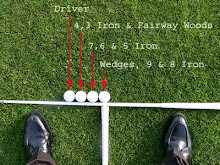This is an interesting article that I found online and one that I agree may help many of you increase your ability to turn and make a more "rounded" swing shape, turning your left to right shots into right to left shots...
We've all read articles and heard TV commentary about restricting your hip turn on the backswing to develop more coil and increase you X-Factor (the differential in degrees of rotation between shoulder rotation and hip rotation). That's all well and good if you are in good "golf" shape with a lot of flexibility and stability. But for many of my students a simple increase in backswing hip rotation increases their clubhead speed and turns their over-the-top fade into a draw. Let me explain why.
First off, we all need to have as large of an X-Factor as we can to achieve maximum clubhead speed. But there is one aspect that is often overlooked. In Jim McLean's original writings in the early 90's he mentioned that the player with the largest X-Factor on the PGA Tour was John Daly. By no small coincidence he was the longest driver on tour at the time. Here's the catch, Daly also had the most hip rotation of the players measured. What we find is that roughly for every degree of hip rotation you get two degrees of shoulder turn. So when we say the model backswing normally has around 90 degrees of shoulder rotation and 45 degrees of hip rotation we see this 2-1 ratio develops an X-Factor of 45. If the hip rotation is increased to 46 degrees that should lead to a shoulder rotation of 92 degrees and an X-Factor of 46.
This scenario has limits, but I have found that for many average players increasing their hip rotation leads to more shoulder rotation. They don't have the flexibility to just restrict their hip turn and turn their shoulders more. The most profound impact is with players who tend to slide their hips more than they rotate them. Those players tend to have some or all of these characteristics. A swing plane that is too steep, upright and over-the-top on the downswing and hit mostly shots that start left of the target and fade or slice to the right. They tend to have their right knee bow on the backswing leading to a rolling of the back foot with weight being on the outside of it. Also, many times their right arm gets too far away from the body and they have what would called a "flying" right elbow. Without having to think about all this many times making sure that the hips turn more on the backswing changes these flaws and produces a swing plane that allows players to deliver the club to ball on an inside path encouraging a draw. For some of these players it's the first time they are aware of properly moving their core mid-section and how activating that can really be the engine that drives their swings. They also feel the production of centrifugal force that helps them properly release and square the clubface.
Finally, remember these points that will prevent too much hip rotation. As long as you keep your front heel down, your back knee flexed and not allow it to float out over the outside half of your back foot I say go for it and start turning those hips.
By John Fiander, PGA Master Professional - PGA.com
Subscribe to:
Post Comments (Atom)





No comments:
Post a Comment